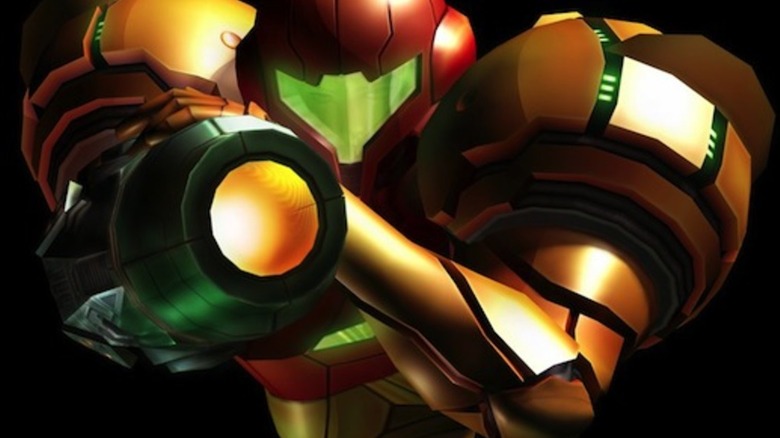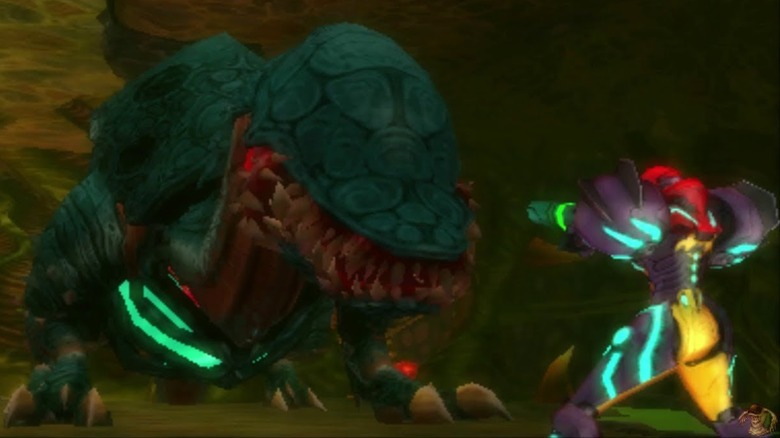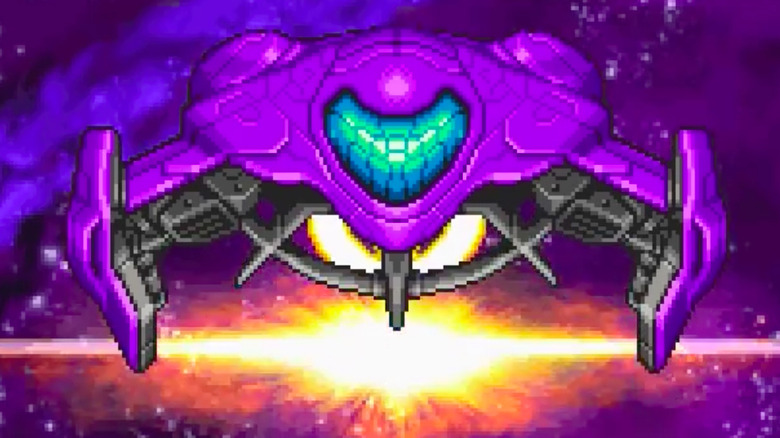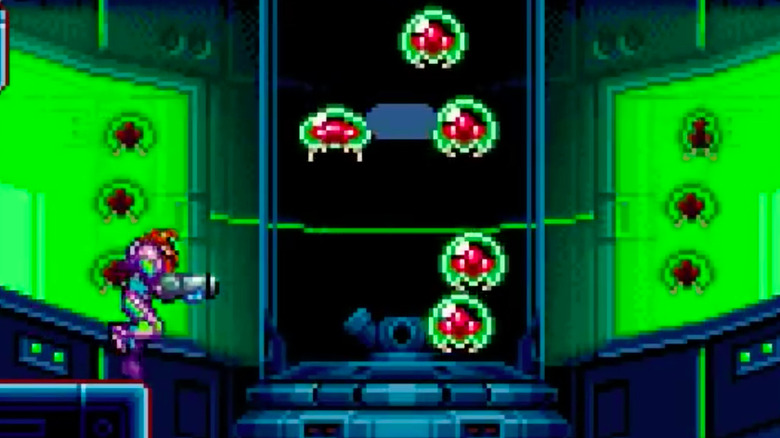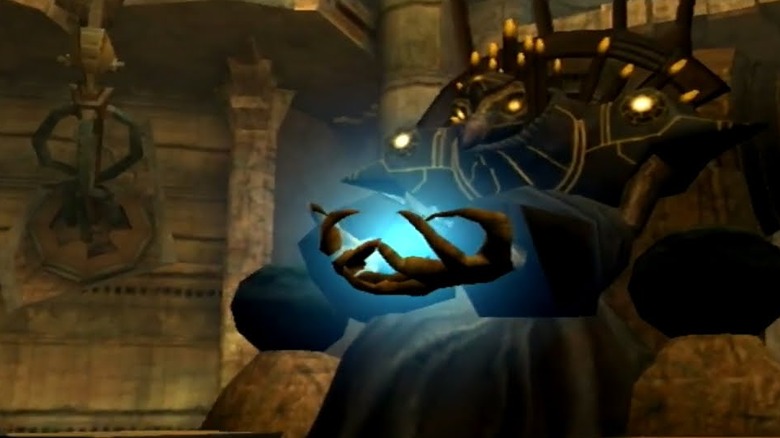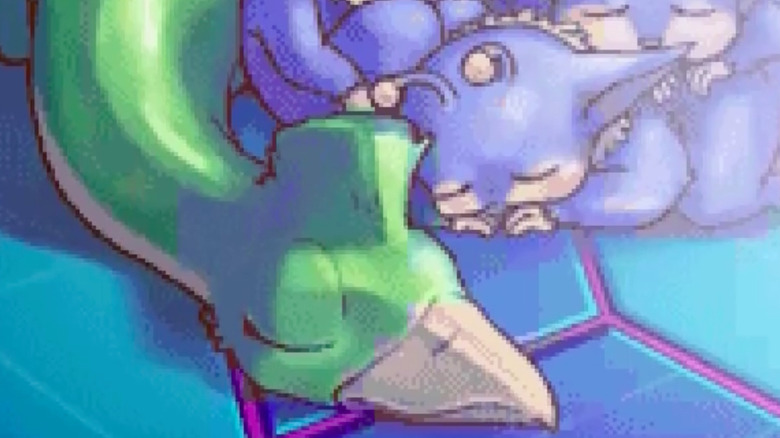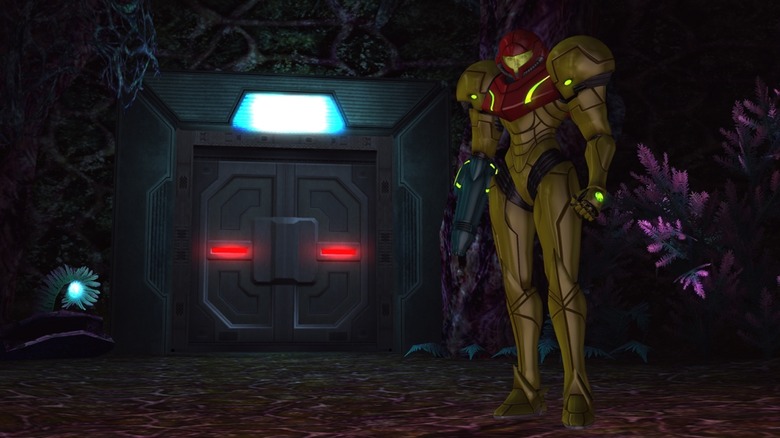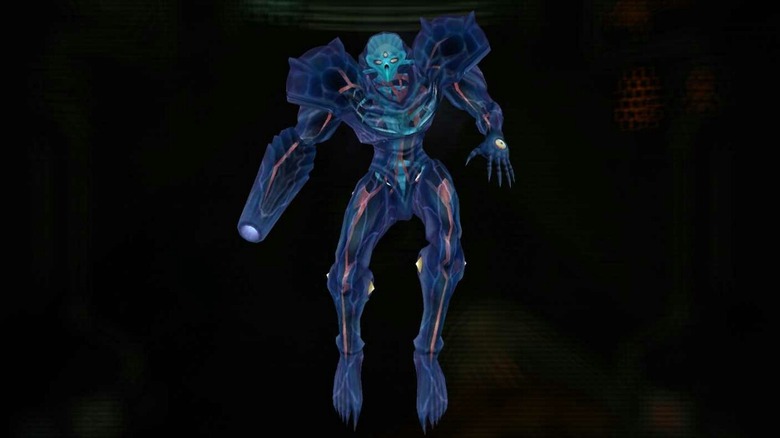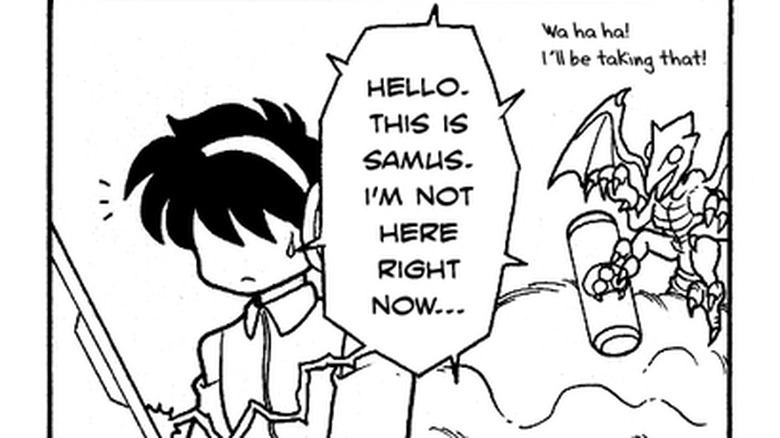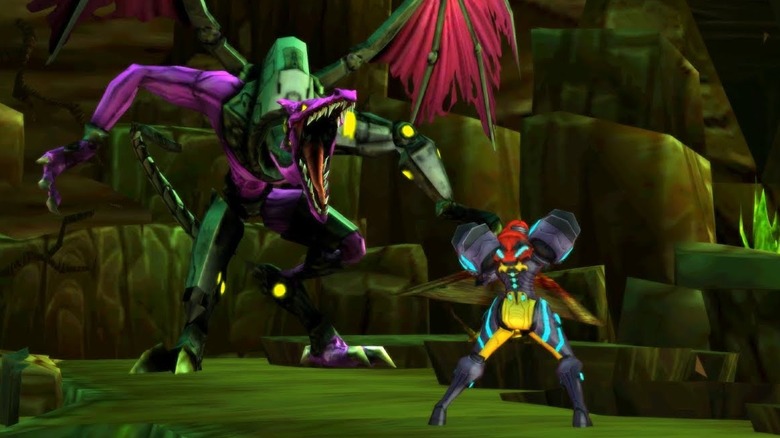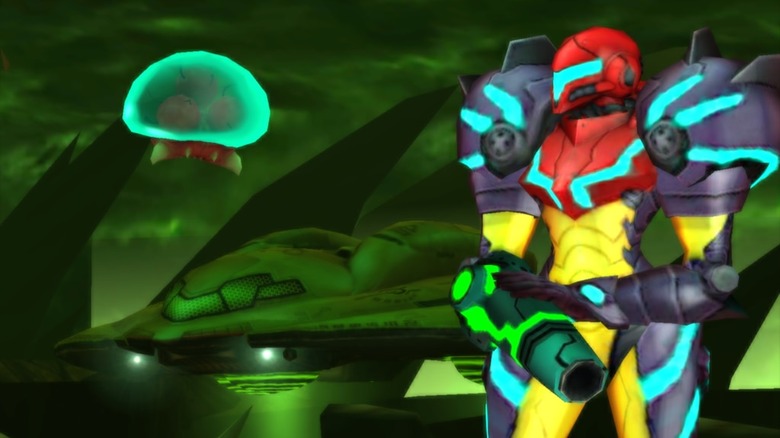The Most Terrible Things Samus Has Ever Done
For those of you who have been living in a hole in the ground of Tallon IV, Samus Aran is the badass female bounty hunter who stars in the Metroid franchise. Rocking her iconic spacesuit, arm cannon, and enough gadgets to make Batman fly into a jealous rage, Samus is known throughout the galaxy as an honorable and powerful warrior, respected by the Galactic Federation (at least at first) and feared by the dreaded Space Pirates.
Over the years and across multiple platforms, Samus has saved the entire universe more than once. Whether she's tackling monsters as varied as Mother Brain and Master Hand or being shot through a pinball machine, Samus Aran always finds a way to win the day with a mix of style, determination, and sheer firepower. In all that time and through all of those battles, she's bound to have made some questionable decisions. More than that, she's been seen to do some downright awful things in the pursuit of galactic peace. Let's take a look at some of them.
Beware: there will be spoilers ahead for the events of the Metroid series.
Actual genocide
It's probably not really something that would stick out to a kid playing the Game Boy classic Metroid 2: Return of Samus, but Samus' mission in that game is really quite sinister. Following the events of the first Metroid, Samus is tasked by the Galactic Federation to go to SR388, the homeworld of the Metroid species, and annihilate every last one of them.
This isn't a case of trying to assign a plot to a fairly basic Game Boy title, by the way. The original instruction manual for Metroid 2 literally read, "[The Galactic Federation] quickly came to one conclusion ... Give Samus Aran the order to exterminate the Metroids!" It doesn't get much more cut and dry than that: Samus' mission was straight-up genocide.
Samus is more than happy to get right to it, also. Honestly, if the Federation didn't eventually start cloning and breeding the Metroids (more on that later), she may have succeeded in wiping them out. The game literally had a tracker that listed how many Metroids were left alive, just so none of them were missed. Samus is nothing if not thorough.
Blowing up SR388
Towards the end of Metroid Fusion, Samus discovers that the Galactic Federation (the supposed good guys) have not only been breeding Metroids, but they've taken an interest in the newly discovered X Parasite, which they hope to run experiments on. This revelation prompts Samus' decision to destroy the entire Biologic Space Laboratories space station. By changing the station's orbit so that it gets yanked down by nearby SR388's gravitational pull, Samus takes out two birds with one stone, blowing up a space station full of X Parasites and SR388, the Metroids' home planet.
While we don't see the surface of SR388 during the events of Fusion, we are told that Sector 1 on the BSL station has been designed to resemble the surface of SR388, complete with multiple species native to that world. It's not much of a leap to assume that many of said species are still very much inhabiting SR388. Or, rather, they were ... before Samus dropped a space station on them and obliterated the entire planet. Sure, that's where the Metroids are originally from, but this is kind of like burning down a rain forest to kill a few poisonous snakes. It's effective, but also a death sentence to every other innocent life on the planet.
While this is the most horrific aspect of Samus' decision to blow up the BSL station, it's not the only consequence ...
Samus also made an enemy of the Galactic Federation
Not only were the Galactic Federation's scientists breeding Metroids (you know, the creatures of which they had previous ordered an outright extermination), but they had also been attempting to prevent Samus from upgrading her weapons, potentially keeping her from properly taking on the Metroids or her X Parasite doppelgänger, the SA-X. In other words, Samus had every right to make the call to disobey the Federation and destroy the laboratory. It wasn't just a moral cause, it was now a matter of survival.
However, while Samus was morally in the right in this case, turning against the Federation in this way may have been the worst decision she could have made in regards to her future, not to mention her career. After destroying a major research station (and blowing up yet another planet in the process), she will likely go from being a respected bounty hunter to being branded an intergalactic terrorist and outlaw. Not only that, but it's unlikely the Federation would ever try to hire Samus to deal with a threat, ever again, meaning the galaxy may be less guarded than ever before.
The fact that Samus even expresses her fear that people will not understand her actions suggests that she knows how much this choice will haunt her. Only time will tell what the true results of Samus' betrayal were, as Metroid Fusion is chronologically the latest installment in Samus' story.
Grave robbing
Ice Beams, Super Bombs, Diffusion Missiles: just where does Samus get all of her wonderful toys? Well, quite a few of them come from raiding tombs like a space age Lara Croft. Many of the planets that Samus finds herself dispatched to contain crypts and ruins left behind by the ancient Chozo race. Since her suit was built by the Chozo, many of the artifacts contained in these areas (usually held by a Chozo statue) can be used to upgrade her abilities.
That's pretty convenient, but it doesn't change the fact that Samus is literally stealing from the dead in order to gift herself with some fancy new equipment. Imagine if Sonic the Hedgehog decided he wasn't going fast enough, so he went into a mausoleum in the Green Hill Zone and took a sweet pair of running shoes right off a corpse. Sounds pretty upsetting, doesn't it? Well, this is basically the same idea.
Nearly every upgrade Samus receives over the course of the Metroid series is either picked off of a dead enemy (and occasionally a friend, as in the tragic case of Rundas in Metroid Prime 3) or taken from ancient Chozo tombs (like the ruins that attack Samus in Metroid: Zero Mission). This becomes even more awful when you consider the fact that Samus seemingly ditches or otherwise loses these upgrades after every mission, starting from scratch and necessitating even more stealing in the next installment.
Not saving the animals
This one is kind of tricky, in that it's part of an optional path at the tail end of Super Metroid, but it's troubling from a canonicity standpoint. After Samus has gained the Speed Booster ability in Super Metroid, she is taught the Shinespark technique by an alien animal called a Dachora. The Shinespark allows Samus to essentially fly in one direction, getting her to otherwise inaccessible areas. Similarly, Samus encounters a group of creatures called Etecoon, which teach her how to Wall Jump.
Following the defeat of Mother Brain at the end of Super Metroid, Samus has very little time to escape Planet Zebes before it explodes. If she stops by a room slightly off the path from her escape route, she can rescue the Dachora and Etecoon, who can be seen escaping Zebes' destruction (in the background). Years later, in Metroid Fusion, Samus encounters Etecoon and Dachora that are strongly implied to be the same ones she met on Zebes. In fact, these animals are integral to Samus' escape from SR388.
Here's the thing, though: rescuing the animals in Super Metroid is entirely optional. In fact, many speedrunners leave the animals behind to die, rather than add precious seconds to their playthrough. Not only is that a callous move that makes Samus look heartless (especially after these creatures have helped her so much), it makes Fusion's ending impossible and would theoretically doom Samus herself.
Shooting EVERY door
Samus wasn't raised by in a barn or by wolves (in fact, she was actually raised by alien bird people). However, that doesn't stop her from being a bit of an inelegant wrecking ball when it comes to entering and exiting rooms. Can you imagine firing a missile every single time you needed to leave your house? Think about it: in every game of the Metroid series, whether she's in an alien hideout or a Federation research facility, it somehow makes sense for her to shoot open every single door she comes across. Presumably the Space Pirates and the Federation don't have to carry armed blasters in the event that they want to go visit a neighbor.
Her flair for the explosive admittedly seems fair when you consider how often she finds herself having to force her way into a restricted area — in that case, it's time to bust out those missiles. But when it's a plain old door to the next room? There's simply no excuse for this behavior, Samus. There's a reason the Chozo gave you one regular hand on that suit of yours. Try knocking or using a handle every once in a while.
Presumably, Samus is paid handsomely for her services, and rightly so. But after any given mission she completes, the repair fees alone must be astronomical. It's no wonder nearly every place she leaves mysteriously has its self-destruct sequence activated.
Destroyed Dark Aether completely
During the events of Metroid Prime 2: Echoes, the planet Aether is corrupted by a type of energy called Phazon, which results in a dimensional rift creating the planet Dark Aether, a sort of evil mirror version of the original Aether. Naturally, Samus obliterates it.
Okay, so it's not quite that simple. First Samus has to confront Emperor Ing, the leader of a shapeshifting race that inhabits Dark Aether. Emperor Ing has taken the Light of Aether, a powerful force that binds together the planet Aether and gives power to the settlements on its surface. After a drawn-out battle, the creature finally falls, releasing the Light of Aether. Samus absorbs the Light into her suit, immediately destabilizing Dark Aether. She manages to escape the destruction of the planet and returns the Light to its rightful place, but it's kind of hard to get around the fact that Samus just annihilated an entire alternate dimension.
This one is different from the destruction of SR388 in that Samus didn't have much choice in the matter. If she didn't retrieve the Light of Aether, the planet would have been destroyed. This was essentially a choice between the lesser of two evils. Samus saved the true, uncorrupted version of Aether, but at the cost of yet another planet and every living thing on it, evil or not. So, you know, still pretty ruthless on Samus' part.
Leaving people to die (for the sake of comedy)
This one holds the distinction of being both adorable and horrifying. 1994 saw the release of a manga series loosely based on the events of Super Metroid. This series featured short strips lampooning moments from the game and starred a sillier, somewhat ditzier version of Samus.
In one of the more memorable strips from the series, titled "I Don't Wanna Work!," readers are dropped in on Ridley's fateful attack on Ceres Space Colony, the inciting incident of Super Metroid. In the game, Samus receives a distress signal from Ceres and rushes back to confront Ridley. Here, however, she lets her answering machine pick up the distress call and pretends she can't hear the cries for help. Though the comic is played for laughs, including Ridley's taunts in the background, it's chilling to think of Samus just taking a snooze while an entire space colony is wiped out.
It's worth mentioning that, although the manga was officially licensed by Nintendo, this version of events isn't in canon. However, that doesn't completely let Samus off the hook for the destruction of Ceres.
She didn't double-tap Ridley
Ridley has been a consistent thorn in Samus' side since the very beginning, recurring more than any other boss enemy in the series. He's the Jason Voorhees of the Metroid series: they're both big, dangerous, and constantly resurrecting (not to mention, they've both been turned into cyborgs). WHY, then, Samus doesn't check to make sure he's good and dead at the end of Samus Returns is a complete head-scratcher, especially for fans who know what comes next.
Samus Returns is largely a retelling of Metroid 2: Return of Samus, much in the same way that Metroid: Zero Mission retold the original game's story in an enhanced fashion. At the end of Samus Returns, Ridley attacks Samus on SR388 and tries to steal the Baby Metroid from her to take to Mother Brain. Following Ridley's defeat, Samus Returns plays out like the ending of original Metroid 2, with Samus leaving the planet with the hatchling in tow. As mentioned before, we know from Super Metroid that she delivers the Baby to the scientists on Ceres for safekeeping, which leads to Ridley's attack on Ceres.
Here's the problem, though: Ridley doesn't appear in the original Metroid 2, so his appearance in Samus Returns suggests a huge oversight on Samus' part. By not checking to make sure Ridley is truly down for the count after their fight on SR388, she's indirectly responsible for his attack on Ceres Space Colony just a short time later.
Samus shouldn't have saved the hatchling
This will possibly be the most controversial entry on this list, but just hang in there. While it's true that the Baby didn't pose much of a threat to Samus after the newborn parasite imprinted on her, believing the bounty hunter to be its mother, there's still a case to be made here. Samus, who normally shoots first and asks questions never, could have averted many of the most awful moments of pain and suffering in the Metroid series if she had simply finished her mission and eliminated the hatchling.
The people on Ceres wouldn't have been massacred by Ridley, but also the Federation wouldn't have gotten their grubby mitts on the Metroid hatchling to use for their own nefarious purposes. From the previously mentioned Metroid breeding project in Fusion to the cloned, Ice Beam-impervious Metroids of Metroid: Other M that led to the death of Samus' Commanding Officer, it's hard to deny that Samus Aran could have saved herself and the galaxy a lot of grief if she'd given that last Metroid the ol' "five missiles" treatment. These kind of tough calls are the reason that Samus is presumably paid the big Space Bucks, and she made the wrong call. Harsh, but true.

